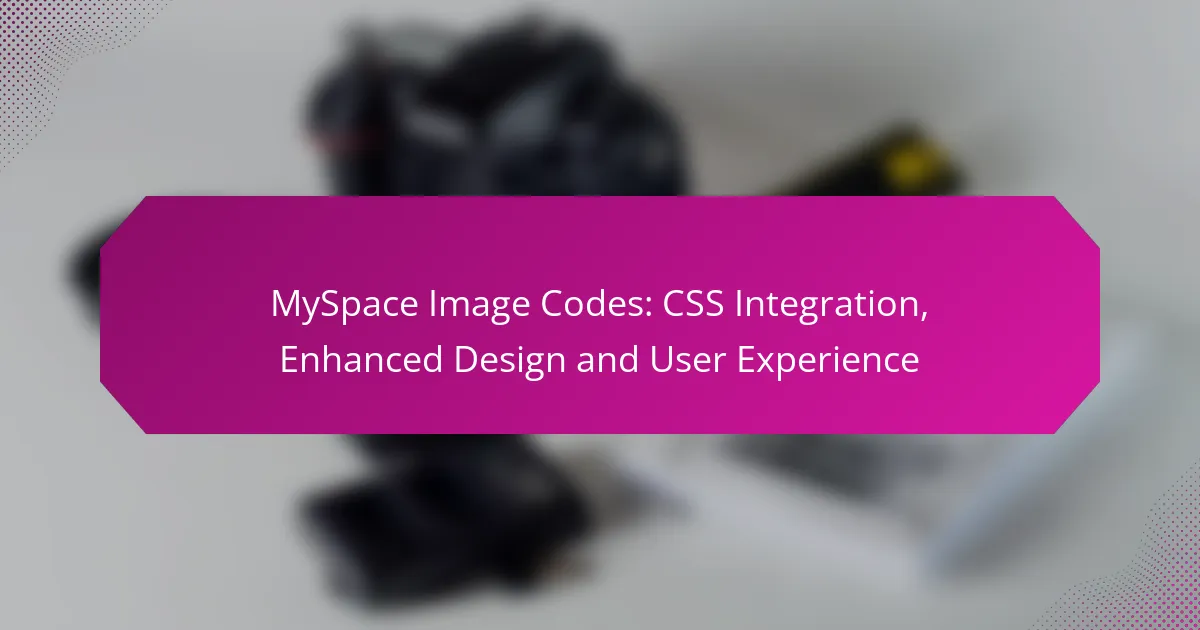Integrating CSS into MySpace image codes significantly enhances the visual appeal and user experience of your profile. By controlling layout, style, and responsiveness, you can create a more engaging environment that encourages interaction. Focusing on aesthetics, usability, and device adaptability is essential for optimizing your profile’s design.
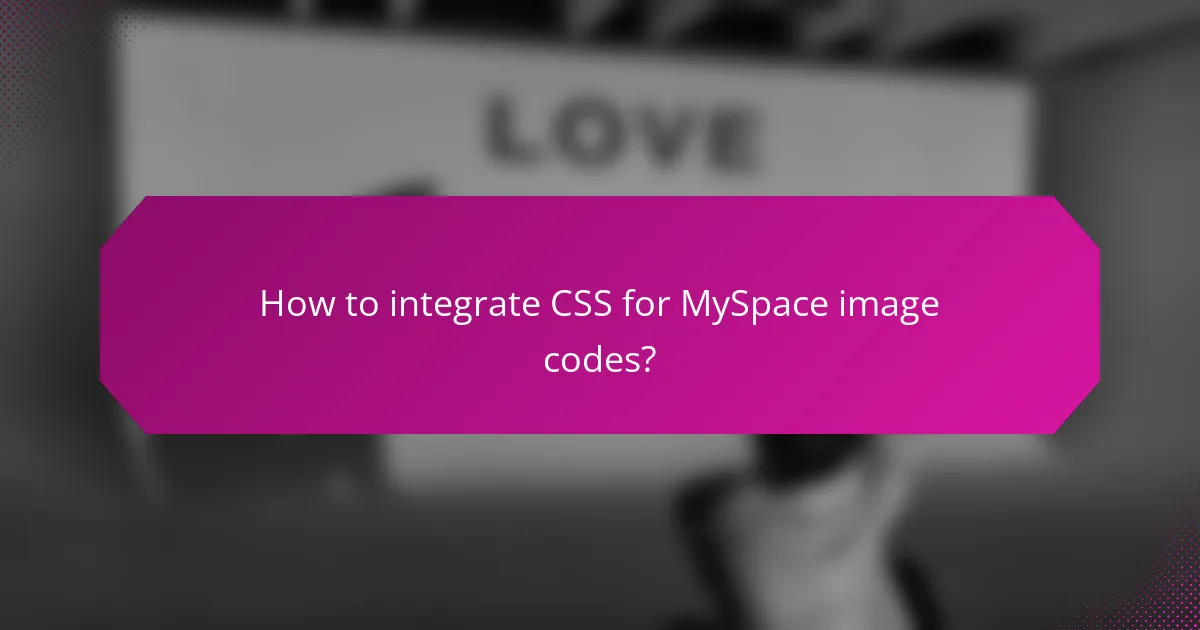
How to integrate CSS for MySpace image codes?
Integrating CSS for MySpace image codes enhances the visual appeal and user experience of your profile. By using CSS, you can control the layout, style, and responsiveness of images, making your profile more engaging.
Using inline CSS styles
Inline CSS styles allow you to apply specific styles directly to individual image elements within your MySpace profile. This method is straightforward and effective for quick adjustments, such as changing the border or padding of an image.
To use inline styles, add the style attribute directly to your image tag. For example: <img src="image.jpg" style="border: 2px solid red;">. This approach is best for minor tweaks but can become cumbersome for multiple images.
Applying external stylesheets
External stylesheets provide a more organized way to manage CSS for your MySpace images. By linking to a separate CSS file, you can maintain consistent styles across multiple images and elements on your profile.
To implement this, create a CSS file and link it in your profile settings using the <link> tag. For example: <link rel="stylesheet" type="text/css" href="styles.css">. This method is ideal for larger profiles where uniformity is key.
Utilizing CSS frameworks
CSS frameworks offer pre-designed styles and components that can significantly speed up the design process for your MySpace profile. Frameworks like Bootstrap or Foundation provide responsive design features, making your images look great on various devices.
To use a framework, include its CSS file in your profile and apply the predefined classes to your image tags. For instance, using Bootstrap, you could add class="img-fluid" to ensure your images are responsive. This approach is beneficial for users looking to create a polished, professional appearance quickly.
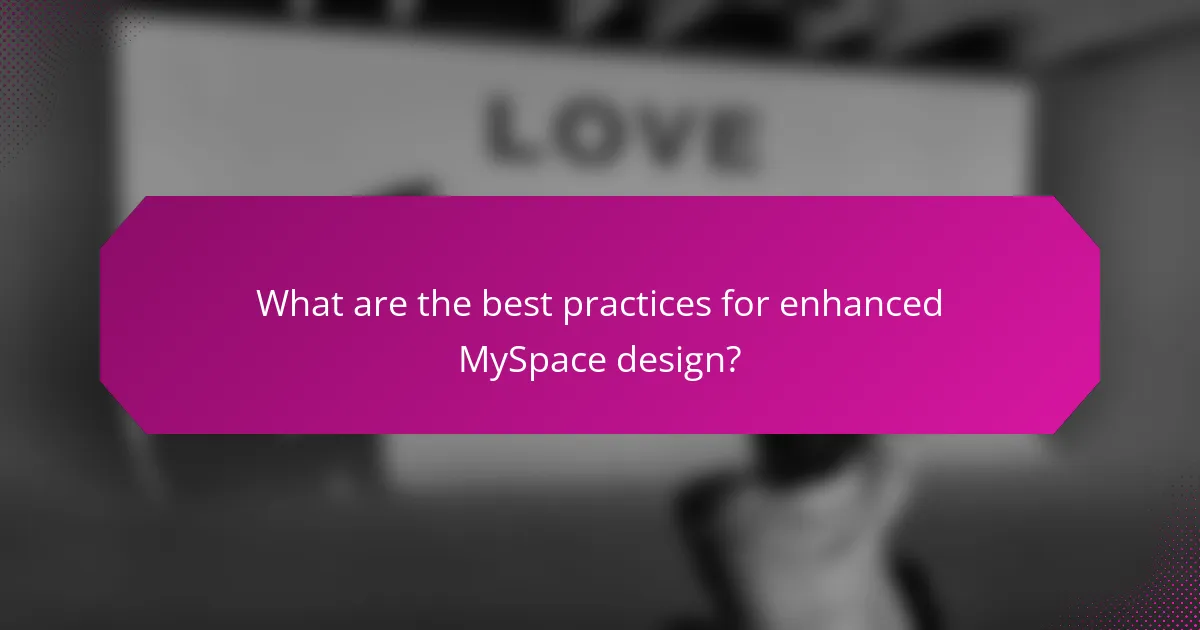
What are the best practices for enhanced MySpace design?
To enhance MySpace design, focus on aesthetics, usability, and responsiveness. Implementing effective color schemes, optimizing images, and ensuring your design adapts to various devices are essential for a better user experience.
Choosing the right color schemes
Selecting appropriate color schemes is crucial for creating an engaging MySpace profile. Aim for a palette that reflects your personality while ensuring readability and visual harmony. Tools like Adobe Color can help you find complementary colors.
Consider using a base color with two or three accent colors. For example, a soft blue background with white text and orange highlights can create an inviting atmosphere. Avoid overly bright or clashing colors that can overwhelm visitors.
Optimizing image sizes
Optimizing image sizes is vital for fast loading times and a smooth user experience. Aim for images that are no larger than 100 KB to ensure quick uploads without sacrificing quality. Use formats like JPEG for photos and PNG for graphics with transparency.
Utilize image compression tools such as TinyPNG or ImageOptim to reduce file sizes without noticeable quality loss. Remember to maintain a balance between image clarity and loading speed to keep visitors engaged.
Implementing responsive design
Responsive design ensures your MySpace profile looks great on any device, from desktops to smartphones. Use CSS media queries to adjust layout and elements based on screen size. This adaptability enhances user experience and keeps visitors on your page longer.
Test your design on various devices to ensure compatibility. Avoid fixed-width elements; instead, use percentages for widths and flexible images to allow for seamless scaling. This approach helps cater to a wider audience and improves accessibility.
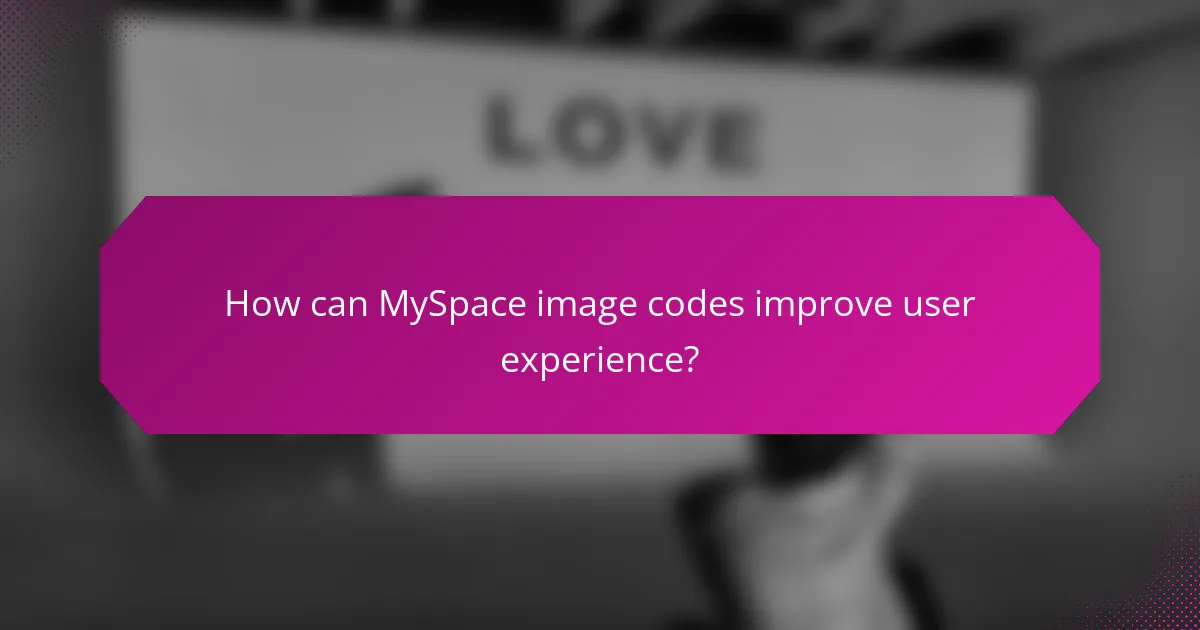
How can MySpace image codes improve user experience?
MySpace image codes can significantly enhance user experience by optimizing how images are displayed and loaded on profiles. By utilizing CSS integration, users can create a more engaging and visually appealing environment that encourages interaction and exploration.
Enhancing loading times
Fast loading times are crucial for retaining user interest. By using optimized image codes, users can reduce the file size of images, which leads to quicker loading times. Aim for images that load in low tens of milliseconds to keep users engaged.
Consider using formats like JPEG or PNG, which are generally more efficient for web use. Additionally, implementing lazy loading techniques can further improve performance by only loading images as they come into the user’s viewport.
Creating visually appealing layouts
Visually appealing layouts can captivate visitors and encourage them to spend more time on a profile. CSS allows for flexible design options, enabling users to customize the placement and appearance of images seamlessly. Use grids or flexbox layouts to create structured and attractive designs.
Incorporate background images or overlays to enhance the aesthetic appeal. Keep in mind that a balanced color scheme and consistent image styles can significantly elevate the overall look of a profile.
Facilitating user engagement
User engagement can be fostered through interactive and dynamic image presentations. By using CSS animations or hover effects, images can become more than just static visuals; they can invite clicks and interactions. For example, images that change on hover can prompt users to explore more content.
Encourage sharing by integrating social media buttons near images, making it easy for users to spread the word about their favorite profiles. Remember that clear calls to action can guide users toward desired interactions, enhancing their overall experience on MySpace.
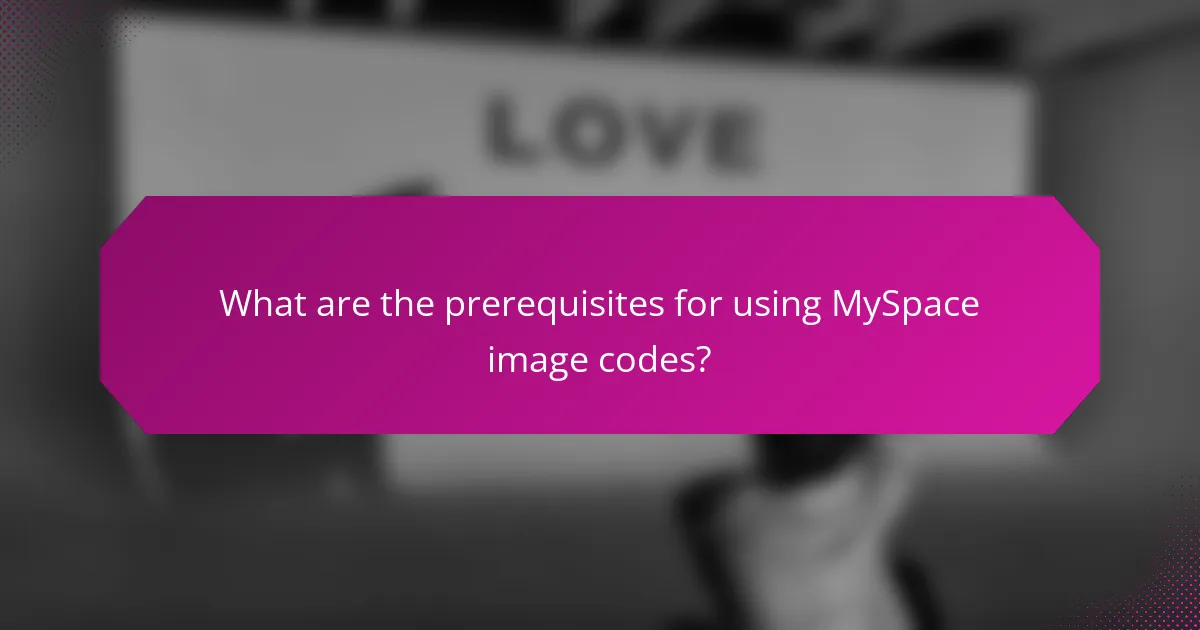
What are the prerequisites for using MySpace image codes?
To effectively use MySpace image codes, you need a basic understanding of CSS and familiarity with the MySpace platform. These skills will enable you to customize your profile and enhance the visual appeal of your content.
Understanding CSS basics
CSS, or Cascading Style Sheets, is essential for styling web pages, including MySpace profiles. Familiarity with CSS syntax, selectors, and properties will allow you to manipulate images, fonts, and layouts effectively.
Key concepts include understanding how to apply styles to specific elements, using classes and IDs, and knowing how to create responsive designs. For instance, using the ‘background-image’ property can help you set a custom image as a profile background.
Familiarity with MySpace platform
Knowing how MySpace operates is crucial for integrating image codes successfully. The platform allows users to customize their profiles using HTML and CSS, but it has specific guidelines and limitations to follow.
Ensure you are aware of the image size restrictions and file formats accepted by MySpace. For example, images should typically be under a certain size limit (often around 2 MB) and in formats like JPG or PNG. Understanding these parameters will help you avoid common pitfalls when uploading images.
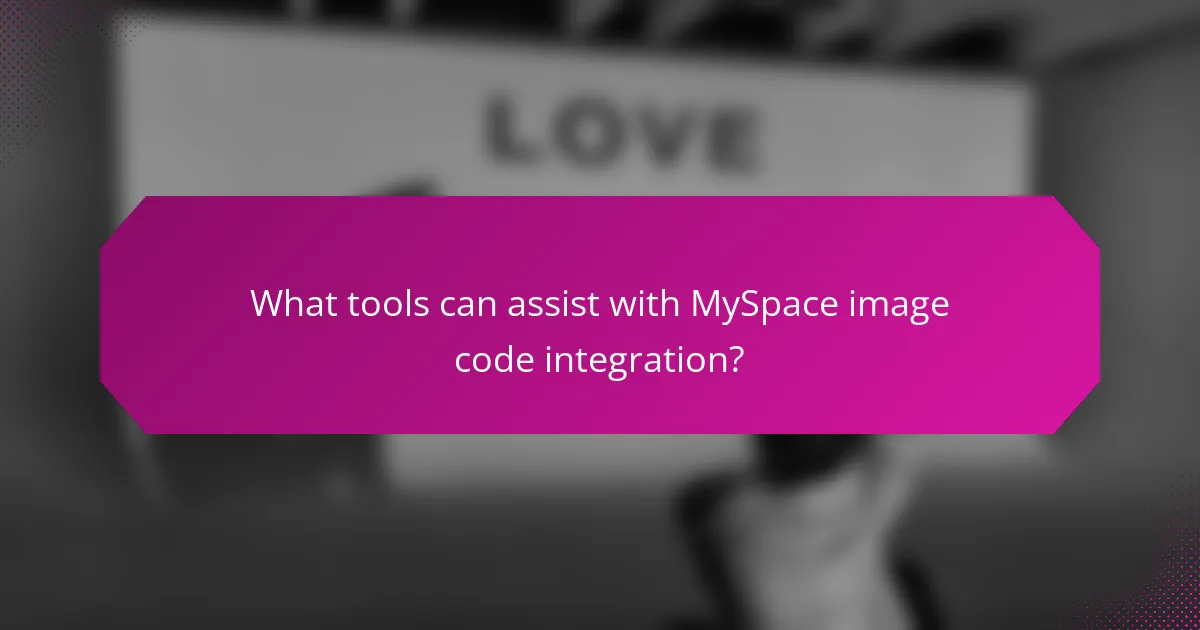
What tools can assist with MySpace image code integration?
Several tools can enhance the integration of image codes on MySpace, focusing on CSS for better design and user experience. Utilizing CSS validators, image editing software, and web design tools can streamline the process and improve overall aesthetics.
CSS validators
CSS validators are essential for ensuring that your code is error-free and compliant with web standards. Tools like the W3C CSS Validation Service can help identify syntax errors and compatibility issues, which is crucial for maintaining a functional MySpace profile.
When using a CSS validator, simply paste your CSS code into the tool, and it will provide feedback on any errors or warnings. Regular validation can prevent issues that may arise from incorrect code, ensuring a smoother user experience.
Image editing software
Image editing software allows you to customize images before integrating them into your MySpace profile. Programs like Adobe Photoshop or free alternatives such as GIMP enable you to resize, crop, and optimize images for faster loading times.
Consider saving images in web-friendly formats like JPEG or PNG to balance quality and file size. Aim for images under 500 KB to ensure quick loading, which is vital for retaining visitors on your profile.
Web design tools
Web design tools, such as Adobe Dreamweaver or online platforms like Wix, can simplify the process of integrating image codes and CSS. These tools often provide drag-and-drop functionality, making it easier to visualize changes in real-time.
Using web design tools can also help you experiment with different layouts and styles without extensive coding knowledge. Look for features that allow for responsive design to ensure your profile looks good on various devices.
